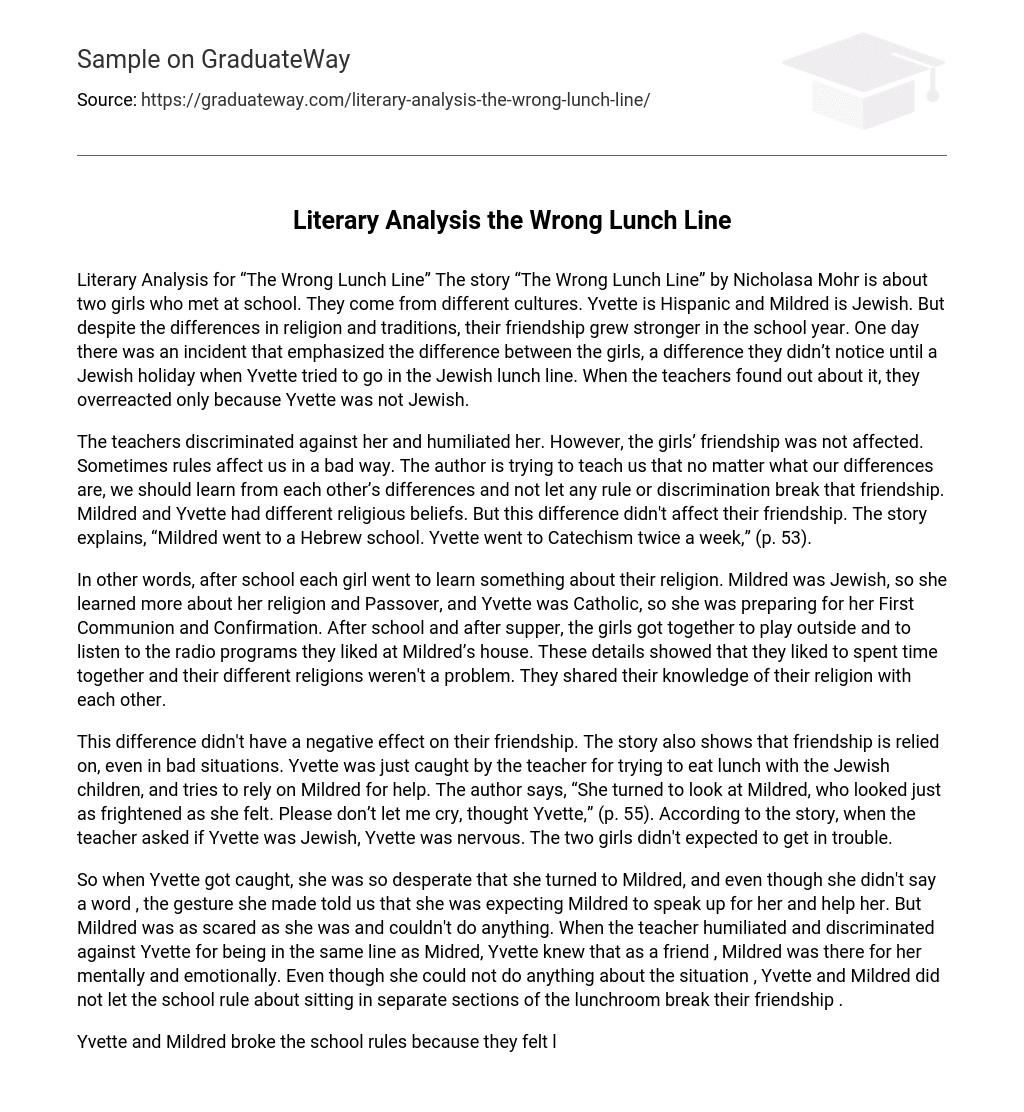Literary Analysis for “The Wrong Lunch Line” The story “The Wrong Lunch Line” by Nicholasa Mohr is about two girls who met at school. They come from different cultures. Yvette is Hispanic and Mildred is Jewish. But despite the differences in religion and traditions, their friendship grew stronger in the school year. One day there was an incident that emphasized the difference between the girls, a difference they didn’t notice until a Jewish holiday when Yvette tried to go in the Jewish lunch line. When the teachers found out about it, they overreacted only because Yvette was not Jewish.
The teachers discriminated against her and humiliated her. However, the girls’ friendship was not affected. Sometimes rules affect us in a bad way. The author is trying to teach us that no matter what our differences are, we should learn from each other’s differences and not let any rule or discrimination break that friendship. Mildred and Yvette had different religious beliefs. But this difference didn’t affect their friendship. The story explains, “Mildred went to a Hebrew school. Yvette went to Catechism twice a week,” (p. 53).
In other words, after school each girl went to learn something about their religion. Mildred was Jewish, so she learned more about her religion and Passover, and Yvette was Catholic, so she was preparing for her First Communion and Confirmation. After school and after supper, the girls got together to play outside and to listen to the radio programs they liked at Mildred’s house. These details showed that they liked to spent time together and their different religions weren’t a problem. They shared their knowledge of their religion with each other.
This difference didn’t have a negative effect on their friendship. The story also shows that friendship is relied on, even in bad situations. Yvette was just caught by the teacher for trying to eat lunch with the Jewish children, and tries to rely on Mildred for help. The author says, “She turned to look at Mildred, who looked just as frightened as she felt. Please don’t let me cry, thought Yvette,” (p. 55). According to the story, when the teacher asked if Yvette was Jewish, Yvette was nervous. The two girls didn’t expected to get in trouble.
So when Yvette got caught, she was so desperate that she turned to Mildred, and even though she didn’t say a word , the gesture she made told us that she was expecting Mildred to speak up for her and help her. But Mildred was as scared as she was and couldn’t do anything. When the teacher humiliated and discriminated against Yvette for being in the same line as Midred, Yvette knew that as a friend , Mildred was there for her mentally and emotionally. Even though she could not do anything about the situation , Yvette and Mildred did not let the school rule about sitting in separate sections of the lunchroom break their friendship .
Yvette and Mildred broke the school rules because they felt like this rule was bad and they didn’t know that their differences would cause a big problem for them. The school rules were based on religious and economic discrimination. Yvette, a Hispanic, went to the Jewish lunch line , and according to the school rules , this put her into trouble . According to the story, the vice principal tells Yvette ,” Don’t go where you don’t belong “(p. 56). This was a warning to her because Yvette was in the line with the Jewish kids.
The vice principal gave Yvette this advice to point out that she was different . The girls just wanted to sit together because they were best friends and at that moment they didn’t think about the consequences. They broke the school rules because they didn’t see anything wrong with sitting together. They didn’t care about their differences . The author is trying to show us the discrimination by the vice principal. Mildred and Yvette were embarrassed about the incident, they wanted to talk about it but they didn’t want to remember that uncomfortable event.
They felt like talking about the incident would bring a discussion about their differences but they didn’t care about them , they just wanted to continue being best friends. According to the article ,”Somehow each girl was afraid of disturbing that feeling of closeness they felt for one another”(p. 57). In other words, the girls didn’t want to bother each other talking about the incident because they didn’t want to reduce or lose those good feelings of strong friendship that they felt for each other.
They just wanted to talk or have fun like they used to do it before the incident, and they did it. They broke their silence and started making jokes about the vice principal and having fun. They didn’t feel like the incident made them to lose the feeling they had for each other , it made their friendship stronger. They didn’t talk about their differences because those weren’t important for them , they just wanted to continue their friendship. “The Wrong Lunch Line” by Nicholasa Mohr teaches that we don’t have to be worried about the differences between us.
We all have different religions, beliefs, economic situations, mores, etc, but we should put those differences away because sometimes we can hurt people or make that any kind of relationship ends. Mildred and Yvette’s example is important for society, it shows that it doesn’t matter how many differences they had , they still are friends because they like each other and they didn’t let people to destroy their friendship. People in our society should learn from this example, we have to stop discriminating others, we shouldn’t let people’s prejudices break our relationships with others.





